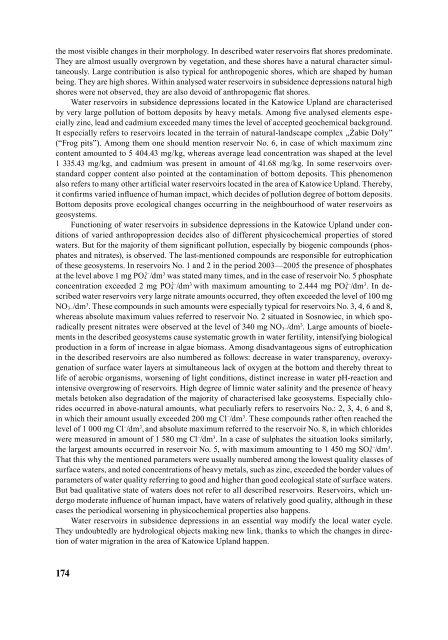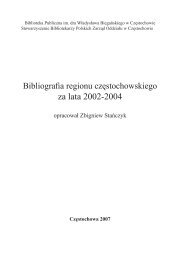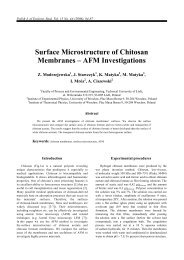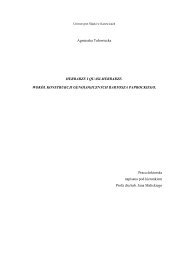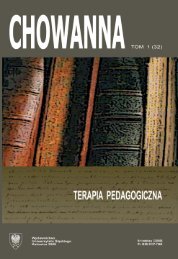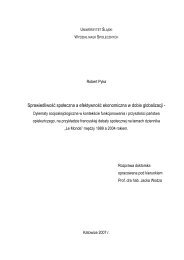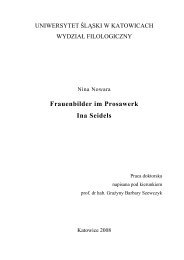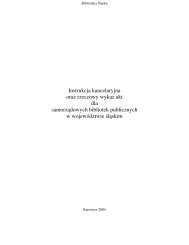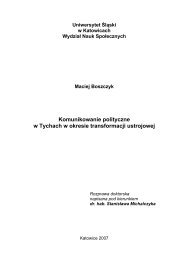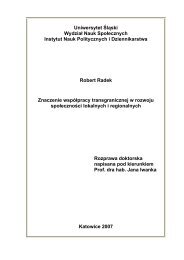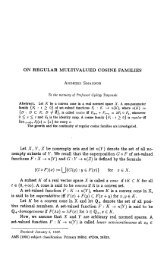3 Charakterystyka zbiorników wodnych - Śląska Biblioteka Cyfrowa
3 Charakterystyka zbiorników wodnych - Śląska Biblioteka Cyfrowa
3 Charakterystyka zbiorników wodnych - Śląska Biblioteka Cyfrowa
- No tags were found...
Create successful ePaper yourself
Turn your PDF publications into a flip-book with our unique Google optimized e-Paper software.
the most visible changes in their morphology. In described water reservoirs flat shores predominate.They are almost usually overgrown by vegetation, and these shores have a natural character simultaneously.Large contribution is also typical for anthropogenic shores, which are shaped by humanbeing. They are high shores. Within analysed water reservoirs in subsidence depressions natural highshores were not observed, they are also devoid of anthropogenic flat shores.Water reservoirs in subsidence depressions located in the Katowice Upland are characterisedby very large pollution of bottom deposits by heavy metals. Among five analysed elements especiallyzinc, lead and cadmium exceeded many times the level of accepted geochemical background.It especially refers to reservoirs located in the terrain of natural-landscape complex „Żabie Doły”(“Frog pits”). Among them one should mention reservoir No. 6, in case of which maximum zinccontent amounted to 5 404.43 mg/kg, whereas average lead concentration was shaped at the level1 335.43 mg/kg, and cadmium was present in amount of 41.68 mg/kg. In some reservoirs overstandardcopper content also pointed at the contamination of bottom deposits. This phenomenonalso refers to many other artificial water reservoirs located in the area of Katowice Upland. Thereby,it confirms varied influence of human impact, which decides of pollution degree of bottom deposits.Bottom deposits prove ecological changes occurring in the neighbourhood of water reservoirs asgeosystems.Functioning of water reservoirs in subsidence depressions in the Katowice Upland under conditionsof varied anthropopression decides also of different physicochemical properties of storedwaters. But for the majority of them significant pollution, especially by biogenic compounds (phosphatesand nitrates), is observed. The last-mentioned compounds are responsible for eutrophicationof these geosystems. In reservoirs No. 1 and 2 in the period 2003—2005 the presence of phosphatesat the level above 1 mg PO 43−/dm 3 was stated many times, and in the case of reservoir No. 5 phosphateconcentration exceeded 2 mg PO 43−/dm 3 with maximum amounting to 2.444 mg PO 43−/dm 3 . In describedwater reservoirs very large nitrate amounts occurred, they often exceeded the level of 100 mgNO 3−/dm 3 . These compounds in such amounts were especially typical for reservoirs No. 3, 4, 6 and 8,whereas absolute maximum values referred to reservoir No. 2 situated in Sosnowiec, in which sporadicallypresent nitrates were observed at the level of 340 mg NO 3−/dm 3 . Large amounts of bioelementsin the described geosystems cause systematic growth in water fertility, intensifying biologicalproduction in a form of increase in algae biomass. Among disadvantageous signs of eutrophicationin the described reservoirs are also numbered as follows: decrease in water transparency, overoxygenationof surface water layers at simultaneous lack of oxygen at the bottom and thereby threat tolife of aerobic organisms, worsening of light conditions, distinct increase in water pH-reaction andintensive overgrowing of reservoirs. High degree of limnic water salinity and the presence of heavymetals betoken also degradation of the majority of characterised lake geosystems. Especially chloridesoccurred in above-natural amounts, what peculiarly refers to reservoirs No.: 2, 3, 4, 6 and 8,in which their amount usually exceeded 200 mg Cl − /dm 3 . These compounds rather often reached thelevel of 1 000 mg Cl − /dm 3 , and absolute maximum referred to the reservoir No. 8, in which chlorideswere measured in amount of 1 580 mg Cl − /dm 3 . In a case of sulphates the situation looks similarly,the largest amounts occurred in reservoir No. 5, with maximum amounting to 1 450 mg SO 43−/dm 3 .That this why the mentioned parameters were usually numbered among the lowest quality classes ofsurface waters, and noted concentrations of heavy metals, such as zinc, exceeded the border values ofparameters of water quality referring to good and higher than good ecological state of surface waters.But bad qualitative state of waters does not refer to all described reservoirs. Reservoirs, which undergomoderate influence of human impact, have waters of relatively good quality, although in thesecases the periodical worsening in physicochemical properties also happens.Water reservoirs in subsidence depressions in an essential way modify the local water cycle.They undoubtedly are hydrological objects making new link, thanks to which the changes in directionof water migration in the area of Katowice Upland happen.174


